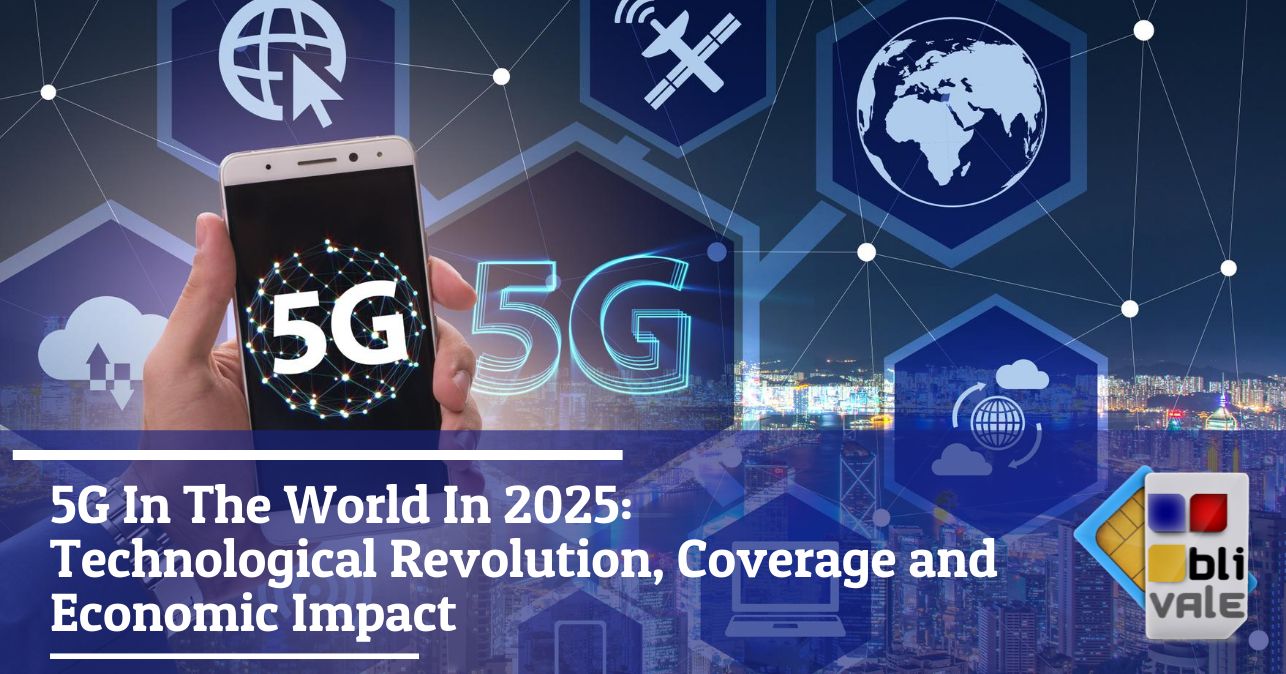Have you ever wondered how widespread 5G really is today? Find out where you can surf at the fastest speed and what impact this revolutionary technology is having on global economies!
5G is more than just a mobile connectivity upgrade: it is the backbone of the next industrial and digital revolution. By 2025, this technology has already radically transformed the way we communicate, work and live, reaching over 2.25 billion global connections - a growth four times greater than 4G during the same period of its development.
🌍 The Global Diffusion of 5G: Where We Are Today
Planning an international trip and worried about connectivity? Know that by the end of 2025, 5G will cover approximately 53% of the world's population , reaching more than 4 billion people.
The undisputed leaders in this technological race are China, the United States, South Korea and Japan, both in terms of the number of cities covered and the extension of the network. In Asia, we are seeing growth driven by massive investments and rapid expansion of infrastructure, while in Europe adoption is slower, but with increasingly widespread coverage in major cities.
"5G is not just about speed: it is the basis for the development of smart cities, autonomous vehicles, telemedicine and the Internet of Things on a global scale."
Table: 5G Coverage in Major Countries of the World (2025)
💰 The Economic Impact of 5G: A Revolution in Numbers
Have you ever wondered how much this technological revolution is really worth? The economic impact of 5G is simply extraordinary. According to GSMA estimates, 5G networks will contribute approximately $2.2 trillion to the global economy between 2024 and 2034.
In Europe, this technology will add €164 billion to the economy over the next five years, with 34% of the benefits coming from the manufacturing sector. For Italy, the economic value of 5G is estimated at over €14 billion , more than double the investments needed to implement the infrastructure.
How 5G Is Transforming Strategic Industries
5G is not just connection speed: it is a powerful catalyst for innovation in key sectors of the economy:
Manufacturing and utilities : Automation, smart factories and production efficiency (33% of global economic impact)
Professional and financial services : Accelerated digitalization and new services (30%)
Public administration : Smart city and digital public services (16%)
ICT and commerce : Advanced e-commerce, cloud and digital platforms (14%)
Agriculture and Mining : Remote Monitoring and Process Automation (6%)
The Multiplier Effect of 5G
More than a technology, 5G is an enabling factor for:
Internet of Things (IoT)
Smart city
Industrial digitalization
Connected Healthcare
Advanced Automation
Intelligent resource management
Did you know? A 10% increase in the Digital Intensity Index (DESI) of an EU Member State leads to a 0.65% increase in GDP per capita, potentially increasing EU GDP by over €1 trillion by 2027.
If you are thinking of taking a trip alone or with friends or for work, do not forget the importance of staying connected wherever you are. For unlimited Internet connection, contact BLIVALE where you can get unlimited Internet according to the destinations:
For unlimited plans like data BLIVALE guarantees free roaming anywhere in the world, no additional or hidden costs. Don't let the lack of connection stop you; get ready to explore the world with freedom and spontaneity.
🚧 Challenges to Overcome: Obstacles on the Road to 5G
Despite its many benefits, the global implementation of 5G faces significant challenges that are slowing its widespread diffusion:
1. Expensive and Complex Infrastructures
5G requires a dense network of small cells to support high frequencies, with high costs for installing antennas, fiber optic cables, and advanced systems. The need to upgrade existing infrastructure is a significant obstacle, especially in urban areas where space is limited.
2. Limited Spectrum and Expensive
Have you ever wondered why some areas have 5G and others don’t? 5G operates in higher frequency bands (millimeter waves) that offer more capacity but have shorter ranges. Access to the spectrum is constrained by competitive and expensive auctions governed by individual countries, with limited resources that slow expansion.
3. Uneven Coverage and Digital Divide
The high frequencies of 5G require multiple base stations to ensure effective coverage, with costs often prohibitive in rural areas. This risks further widening the digital divide between cities and peripheral areas, creating first-class and second-class citizens in access to advanced digital services.
4. Environmental and Health Concerns
Although the scientific evidence is reassuring, public concerns persist about exposure to high-frequency electromagnetic radiation. In addition, 5G base stations consume up to 6 times more energy than 4G, raising questions about environmental sustainability.
Table: Summary of Challenges in Implementing 5G
🔮 The Future of 5G: What to Expect
With the rapid growth of networks and the increase in investment, 5G will continue to expand, reaching new areas and offering increasingly advanced services. By 2025, not only large cities but also many rural and peripheral areas will be able to benefit from the potential of this revolutionary technology.
The adoption of 5G represents a strategic lever for economic growth, competitiveness and digital transformation of countries. The benefits are transversal: from the relaunch of industry to the efficiency of public services, from the creation of new jobs to the reduction of operating costs.
The question we need to ask ourselves is no longer “if” 5G will change the world, but “how quickly” it will do so and “how prepared” we are to seize this opportunity.
Want to stay up to date on the latest 5G news around the world? Keep following us to discover all the evolutions of mobile connectivity that are redefining our digital future!









